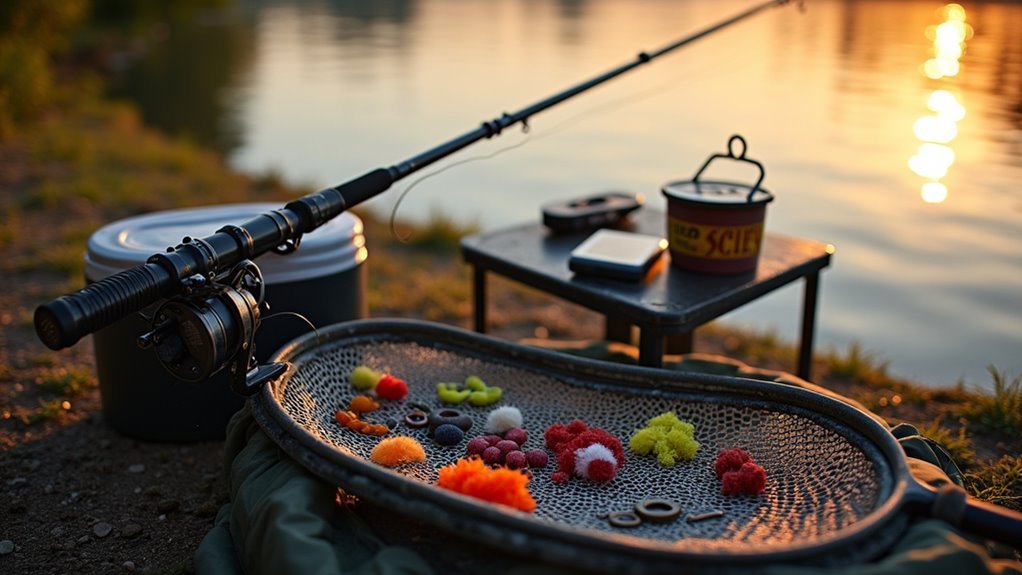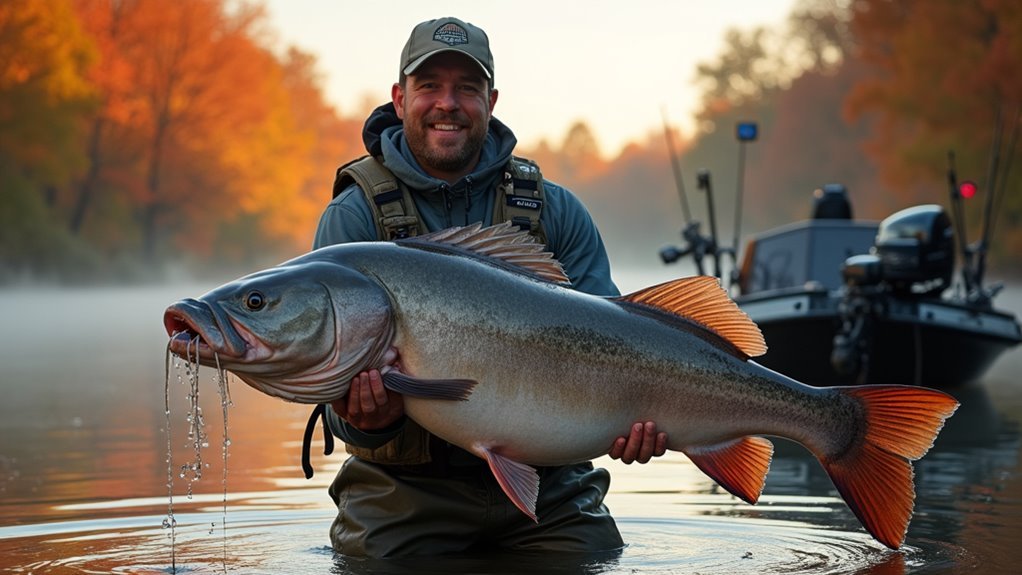Successful catfish fishing hinges on matching your gear to your target species. For trophy cats, you’ll need a sturdy rod, baitcasting reel, and 20-30 pound test line. Different species require different approaches—channels respond to chicken liver, while flatheads prefer live bluegill. Seasonal patterns matter too; spring offers aggressive feeding, while summer pushes cats to deeper, cooler waters. Mastering drift fishing for active periods and still-fishing for nighttime can dramatically improve your chances.
Essential Gear and Equipment for Catfishing Success

Anglers heading out for catfish need the right tools if they’re serious about landing these whiskered giants. A sturdy rod capable of handling heavyweight fighters is essential—particularly when targeting flatheads or blues that can exceed 50 pounds.
Bait-casting reels generally outperform spinning options, offering better drag systems and casting accuracy when it matters. I think 20-30 pound test line strikes the right balance for most situations, though you might want heavier when targeting trophy cats.
Circle hooks are perhaps the most underrated piece of equipment. They practically set themselves and, in my experience, considerably reduce gut-hooking fish you plan to release.
Understanding Catfish Species Behaviors and Habitats
While each catfish species shares some common traits, understanding their unique behaviors and habitats is critical to targeting them effectively.
Channel cats prefer clean waters but adapt to murky conditions, making them versatile targets in most environments. They’re perhaps the most accessible for beginners.
Channel catfish thrive in both clear and murky waters, making them perfect first targets for novice anglers.
Flatheads, on the other hand, are solitary nighttime predators that hide during daylight hours. They’re picky eaters, typically preferring live bait.
Blues are the giants, often found in deeper, current-rich areas where they ambush prey.
I think many anglers overlook bullheads, which, despite their small size, can provide consistent action in the evenings.
Prime Catfish Baits: Live, Cut, and Prepared Options
Three key bait categories stand out when it comes to enticing catfish to bite: live, cut, and prepared options. Different species often respond better to specific baits, though there’s some overlap in what works.
| Catfish Species | Best Live Bait | Best Cut/Prepared Bait |
|---|---|---|
| Channel Catfish | Nightcrawlers | Chicken livers, stink baits |
| Blue Catfish | Sunfish, shad | Fresh cut oily fish |
| Flathead Catfish | Live bluegill | Fresh baitfish (rarely takes prepared) |
I think the freshness factor matters tremendously. While prepared baits might be convenient, nothing beats the natural scent and movement of live options, especially when targeting trophy flatheads.
Seasonal Strategies for Targeting Trophy Catfish

Now that we’ve covered the best bait selections, the timing of when you target trophy catfish becomes just as important as what you put on your hook.
Seasonal patterns dramatically affect where these giants feed and how actively they bite.
Spring offers perhaps the year’s best opportunity for trophy blues and channels as they prepare for spawning. Water temperatures between 65-75°F trigger aggressive feeding behaviors.
Summer shifts these monsters to deeper, cooler waters—especially during daylight.
Fall brings another feeding frenzy as catfish bulk up for winter. I think night fishing becomes particularly effective during this change.
Winter requires patience, but deep holes near structure can still produce surprisingly large cats when approached methodically.
Advanced Techniques: Drift Fishing vs. Still-Fishing
When it comes to landing trophy catfish, mastering different fishing techniques can make all the difference between a successful outing and going home empty-handed.
Drift fishing and still-fishing represent two contrasting but equally effective approaches.
Drift fishing allows anglers to cover more water, using a boat to present baits to catfish over a larger area.
It’s particularly effective for blue catfish hunting in deeper currents. I think it works best during daylight hours when fish are more active.
Still-fishing, perhaps the more traditional method, involves casting and waiting patiently.
It’s ideal for shore anglers and nighttime fishing when catfish, especially flatheads, move into shallower feeding areas.
Handling and Safely Releasing Larger Catfish
Handling large catfish properly isn’t just about protecting yourself from those sharp spines—it’s about respecting these magnificent creatures that might be decades old. When landing a big cat, wet your hands first to preserve their protective slime coat that shields them from disease.
Never grab a catfish by the gills or eyes. Instead, support larger fish horizontally with two hands—one behind the pectoral fins and another at the tail. I think a lip gripper tool works well for blues and channels, though flatheads might be too heavy for this approach.
Perhaps most importantly, minimize time out of water. These simple steps guarantee these impressive fish survive to fight another day.
Frequently Asked Questions
How Do I Find Local Catfish Hotspots Without Expensive Electronics?
Want to find catfish hotspots without expensive gear? Anglers should watch for local fishing spots, river bends, deep holes, or areas with cover. They’ll find success by talking to experienced fishermen too.
Can I Effectively Fish for Catfish From Shore Without a Boat?
Shore fishing for catfish is highly effective. Anglers can target deeper pools, river bends, and structure using still-fishing techniques. They’ll need strong gear and appropriate bait for their target species.
How Do Moon Phases Affect Catfish Feeding Behavior?
The silver eye in the night sky guides catfish behavior. During full moons, they’re often less active with reduced feeding, while new moons typically trigger increased activity and more aggressive hunting patterns.
What’s the Best Bait Storage Method for Multi-Day Fishing Trips?
Anglers should keep baits in airtight containers inside coolers with ice packs. They’ll want to separate different baits to prevent cross-contamination and rotate ice daily to maintain freshness.
How Do I Remove the Fishy Taste From Catfish Fillets?
Ah, the age-old battle against fishy catfish! Anglers can soak fillets in buttermilk overnight, then rinse thoroughly before cooking. They’ll also find removing the dark fatty tissue along the lateral line dramatically reduces that muddy flavor.